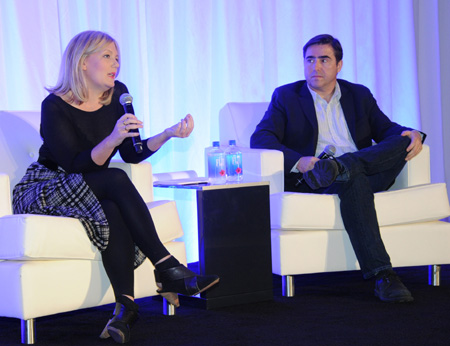AFM advice enhances film output

“Six Stages and 1,000 Hours to Success”
Building your feature film resume involves keen understanding of how a production comes together. Luckily, the American Film Market provides a wealth of insight and tools for achieving that dream.
by Robin Christian
~~~~~
Although I consider myself a “creative,” every decision must be all business when I put on my producer’s hat. With so many movies being made every year, distributors look for any reason not to pick up your independent film. I’m afraid the pitfalls aren’t as clear as they could be; everyone is so busy that you will simply hear “it’s a pass from us” with no explanation as to why they passed.
Examples on how I’ve learned this lesson the hard way include having an opening scene that didn’t clearly lead into the protagonist’s story or several scenes with poor sound design. Those could have been corrected after the fact, but you get one chance to make a positive impression on the sales agent or distributor just as they get one chance to impress a buyer.
Listen to your instinct, your significant other, and your good friends. Weigh carefully each thing pointed out by them and never take negativity personally. You’re entitled to make mistakes, but don’t show the movie to your trusted circle and expect everyone to see past numerous gaffes or unfinished visual effects.

Let’s drill it all the way down. On a single line in the entire two-hour running time of your recently-completed movie, an actor might not sound natural and it is reason enough for the production to be passed up. As much as you would not forgive it while watching a movie in a theater, the blight gives a distributor reason to say “no.” Therefore, do not show your movie until such mistakes are corrected. Back to a movie producer’s business…
A cool story idea is not reason to make a film. It must be profitable. According to producer resources* provided by the American Film Market (AFM), the most profitable indie films in the $0.5 to $3 million budget range have been, in descending order: horror, documentaries with built-in audiences, feel-good religious films, and high-quality dramas. Again, this is for low-budget films and doesn’t take into account the movies produced by mini-studios, major mini-studios, Hollywood majors, and so on.
I assume you are like me and have trouble raising six to seven figures for your budget. Thus, our film has to have more bang for the buck than anything else out there!

Here is a business model that I heard repeated often during AFM 2015:
1. You raise a third of the movie’s budget using private equity. Techniques in raising money for films could fill a few books’ worth, while certain practices are employed widely. One is that investors have more ways to write off an investment; Section 181 in Illinois, for instance, allows for deductions against their capital gains. Another helpful fact is that equity is no longer 100 percent of a movie’s budget.
2. Once you have raised equity and it is “banked,” meaning that it is held in escrow so the investors know you aren’t spending it yet, try to secure an actor who has clearly been in profitable movies similar to yours. They should have played principal roles, appearing in approximately 25 to 30 scenes or more per film, and not just minor character parts. Your name talent may require you to be insured (e.g., a bond) so that he or she gets paid even if the movie does not go into production.
3. With this “name” in the wings, your movie may qualify for “pre-sales” whereby a reputable distributor will sell territories based on your movie before it is made; they know it is bonded despite the risk. Pre-sales increase your budget as will tax credits and rebates, if you shoot the movie in a location that pays you back because you helped their economy and community goodwill. Movies are still fun, yeah!
4. Some producers will also secure “gap” financing to raise the desired budget goal they want for the movie. There are many lenders for this type of financing and they are typically “last in, first out” as far as recouping investments; this is acceptable as long as your other investors agree to it.

So many college students approach me because they want to get production experience but are not familiar with the six primary phases of filmmaking, let alone the hundreds of jobs involved with the process apart from being a producer or director. You must consider that every movie has at least those six important steps that require undivided attention:
Development
First, you need to find an original script. Make it a story that truly needs to be told, one you are willing to spend 1,000 hours of your life bringing to fruition. Unless I am making an artsy or decidedly controversial film that will hopefully say something new, turn heads, win film festival awards, and become a critical darling, it must be saleable – meaning, profitable. What is the genre(s)? Who is your target audience? Have similar movies made a profit? Once the script or story is set, you might have good ideas for people who can help produce. However, before you can make a wish list of crew, locations, and recognizable cast, you will face the biggest roadblock of them all, funding. If you secure that fabled six-figure budget to cover the base production values, then “bravo!” You are prepared for the next step.
Pre-production
We know you will shoot the movie now, so everything must be meticulously planned out. This includes fallback plans; I always try to pick two back-ups for every speaking role or crew member and three alternate choices for locations should any fall through.
Production
It’s happening! A shooting schedule is typically three six-day weeks for $100-$200 thousand budget, four weeks for $500 thousand budget, and so on. Besides higher production values, more money affords you the time to properly make your movie.
Post-production
This tends to be a difficult step, primarily because many budgets are sucked dry during pre-production and production. Such a shortfall may not leave enough for properly scoring the music, working with great sound mixers or colorists, affording song clearances, or even promoting the finished film.
Distribution
An ideal scenario is to sell your movie outright for a large advance plus a 70/30 percent split with the distributor into perpetuity. This is rare unless you have a hit or win an award at one of the top 20 film festivals with your film, or had a pre-sale deal already set in stone.
Marketing
If you haven’t left much budget for promoting the movie, it could be a struggle to get notice. If your movie is in wide release, you will be in good shape. However, the books never close so neither should your tenacity. Social media tools and public relations are good ways to keep your film in the spotlight for years to come, but they can require as much as 10 hours per week to properly maintain. Try to enlist fans of the film to help!

Note that each step I’ve mentioned here took me years to hone into a skillset. My best resource has been attending the American Film Market, which returns next week to Santa Monica, CA, and runs November 2-9. Any year you can attend AFM, you will have everyone you’d want to ask about the motion picture business under just a few rooftops!
*Report information provided by Stephen Follows and Bruce Nash.
~~~~~

~~~~~
Robin Christian is a freelance journalist and an award winning writer, director, and producer of feature films. Read his other festival coverage on C-U Blogfidential:
AFM 2014 . AFM 2013 . AFM/AFI Fest 2010 . NAPTE 2010
Article © 2016 Robin Christian. Used with permission.
CUBlog edits © 2016 Jason Pankoke
AFM graphics: Invision/AP for AFM © 2015